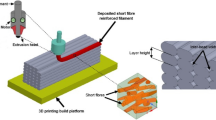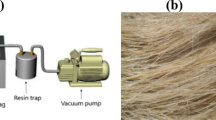Abstract
The nature and properties of the resistance to fibre-matrix interfacial debonding in composites composed of ductile fibres in a brittle or elastic matrix can be determined using the single-fibre pull-out test. The results of such tests on cementitious matrix specimens indicate a non-linear relationship between the debonding and/or pull-out load and the embedded length of the fibre. Several of the theories developed to explain the debonding process and enable estimation of the parameters representing the debonding resistance through an analysis of pull-out test results are reviewed in this first of a two-part paper. The application of these theories to experimental data for steel fibre-cementitious matrix pull-out specimens is examined in the second part.
Similar content being viewed by others
Abbreviations
- b i :
-
effective thickness of the fibre—matrix interface
- d f :
-
diameter of the fibre
- l c :
-
embedded fibre length at which fibre fracture rather than pull-out occurs
- l d :
-
debonded fibre length
- l e :
-
embedded length of the fibre in a pull-out specimen
- l e, min :
-
a minimum embedded fibre length which equals (1/α2cosh−1 (τib,max/τib,f)1/2
- l k :
-
minimum embedded fibre length required to support the debonding stress in the fibre
- l p :
-
maximum embedded fibre length at which complete debonding occurs instantaneously
- q ib, max :
-
elastic shear flow resistance to fibre-matrix interfacial debonding
- q ib, f :
-
frictional shear flow resistance to slipping at the fibre-matrix interface after the elastic bond has broken
- r f :
-
radius of the fibre
- r m :
-
effective radius of the matrix block in a pull-out test specimen
- A f :
-
cross-sectional area of the fibre
- A m :
-
cross-sectional area of the matrix block in a pull-out test specimen
- C 1 :
-
a constant representing the normal compressive stress at the fibre-matrix interface
- C 2 :
-
a constant representing the coefficient of friction between the fibre and the matrix at the interface
- D :
-
length of the “debonding plateau” (see Fig. 5a)
- E m :
-
modulus of elasticity of the matrix
- E f :
-
modulus of elasticity of the fibre
- G i :
-
shear modulus of the fibre-matrix interface
- G m :
-
shear modulus of the matrix
- P f :
-
load applied to the fibre in a pull-out test
- P f, max :
-
maximum load applied to the fibre in a pull-out test
- P f, ult :
-
applied load at which fibre fracture occurs
- P f, edb :
-
load required to break the adhesional or elastic fibre-matrix interfacial bond in a pull-out test specimen
- P′ f, edb :
-
maximum value of P f, edb (see Fig. 7)
- P f, d :
-
instantaneous decrease in applied fibre load when debonding is complete
- P f,r :
-
residual fibre load required to overcome initial frictional resistance to fibre pull-out
- P f, ∞ :
-
applied fibre load required to debond an infinitely long fibre with no frictional resistance to slipping at the fibre-matrix interface
- α :
-
an elastic constant α 1 = (2G i/b i r f E f)1/2 α 2 = [(2π G m/ln(r m r f))(1/A f E f−1/A m E m)]1/2 α 3=[4π G m/ln(r m/r f)r f E f]1/2 α 4=[G m(A f E f + A m E m/A f E f A m E m)]1/2
- γ i :
-
surface energy of the fibre-matrix interface
- δ f :
-
fibre extension or displacement in a pull-out test
- Δ :
-
slope of the linear portion of the P f, max against α 2 l e curve and is equal to τib,fπd f/α2
- λ :
-
fibre-matrix misfit
- μ :
-
coefficient of friction between the fibre and matrix at the interface
- ν f :
-
Poisson's ratio of the fibre
- ν m :
-
Poisson's ratio of the matrix
- σ f, max :
-
stress in the fibre at which interfacial debonding occurs in a pull-out test specimen, i.e. debonding stress
- σ′ f, max :
-
plateau debonding stress (see Fig. 5b)
- σ f, po :
-
stress in the fibre when fibre pull-out begins, i.e. immediately following the completion of interfacial debonding
- σ f, ult :
-
ultimate tensile strength of the fibre
- σ i, n :
-
normal compressive stress exerted by the matrix on the fibre across the interface
- τ i, av :
-
average shear stress at the fibre-matrix interface
- τ i, max :
-
maximum shear stress at the fibre-matrix interface
- τ ib, av :
-
average shear strength of the fibre-matrix interfacial bond
- τ ib, max :
-
maximum or adhesional shear strength of the fibre-matrix interfacial bond
- τ ib, f :
-
frictional resistance to slipping at the fibre-matrix interface after the elastic bond has broken
References
R. J. Gray and C. D. Johnston, in Proceedings of the RILEM Symposium on Testing and Test Methods of Fibre Cement Composites, The University of Sheffield, April 1978, edited by R. N. Swamy (The Construction Press, Lancaster, 1978) p. 317.
A. Kelly and W. R. Tyson, in “High Strength Materials”, edited by V. F. Zackay (John Wiley and Sons, New York, 1965) p. 578.
L. J. Broutman, in “Interfaces and Composites” ASTM STP 452 (American Society for Testing and Materials, Philadelphia, 1969) p. 27.
G. A. Cooper, J. Mater. Sci. 5 (1970) 645.
B. P. Hughes and N. I. Fattuhi, Mag. Concrete Res. 27 (1975) 1749.
M. Maage, Cem. Concrete Res. 7 (1977) 703.
P. W. R. Beaumont and J. C. Aleszka, J. Mater. Sci. 13 (1978) 161.
R. J. Gray, PhD thesis, The University of Calgary (1982).
L. B. Greszczuk, in “Interfaces in Composites” ASTM STP 452 (American Society for Testing and Materials, Philadelphia, 1969) p. 42.
P. Lawrence, J. Mater. Sci. 7 (1972) 1.
V. Laws, P. Lawrence and R. W. Nurse, J. Phys. D: Appl. Phys. 6 (1973) 523.
A. Takaku and R. G. C. Arridge, ibid 6 (1973) 2038.
D. J. Pinchin and D. Tabor, Cem. Concrete Res. 8 (1978) 139.
Idem, J. Mater. Sci. 13 (1978) 1261.
J. Bowling and G. W. Groves, ibid. 14 (1979) 431.
J. D. Outwater and M. C. Murphy, in Proceedings of the 24th Annual Technical Conference of the Reinforced Plastics/Composites Division, The Society of the Plastics Industry, Inc., Washington, DC, 1969, p. 11-C.
P. Bartos, J. Mater. Sci. 15 (1980) 3122.
Idem, Int. J. Cem. Composites Lightweight Aggregates 3 (1981) 145.
V. Laws, Composites 13 (1982) 145.
Author information
Authors and Affiliations
Rights and permissions
About this article
Cite this article
Gray, R.J. Analysis of the effect of embedded fibre length on fibre debonding and pull-out from an elastic matrix. J Mater Sci 19, 861–870 (1984). https://doi.org/10.1007/BF00540456
Received:
Accepted:
Issue Date:
DOI: https://doi.org/10.1007/BF00540456




